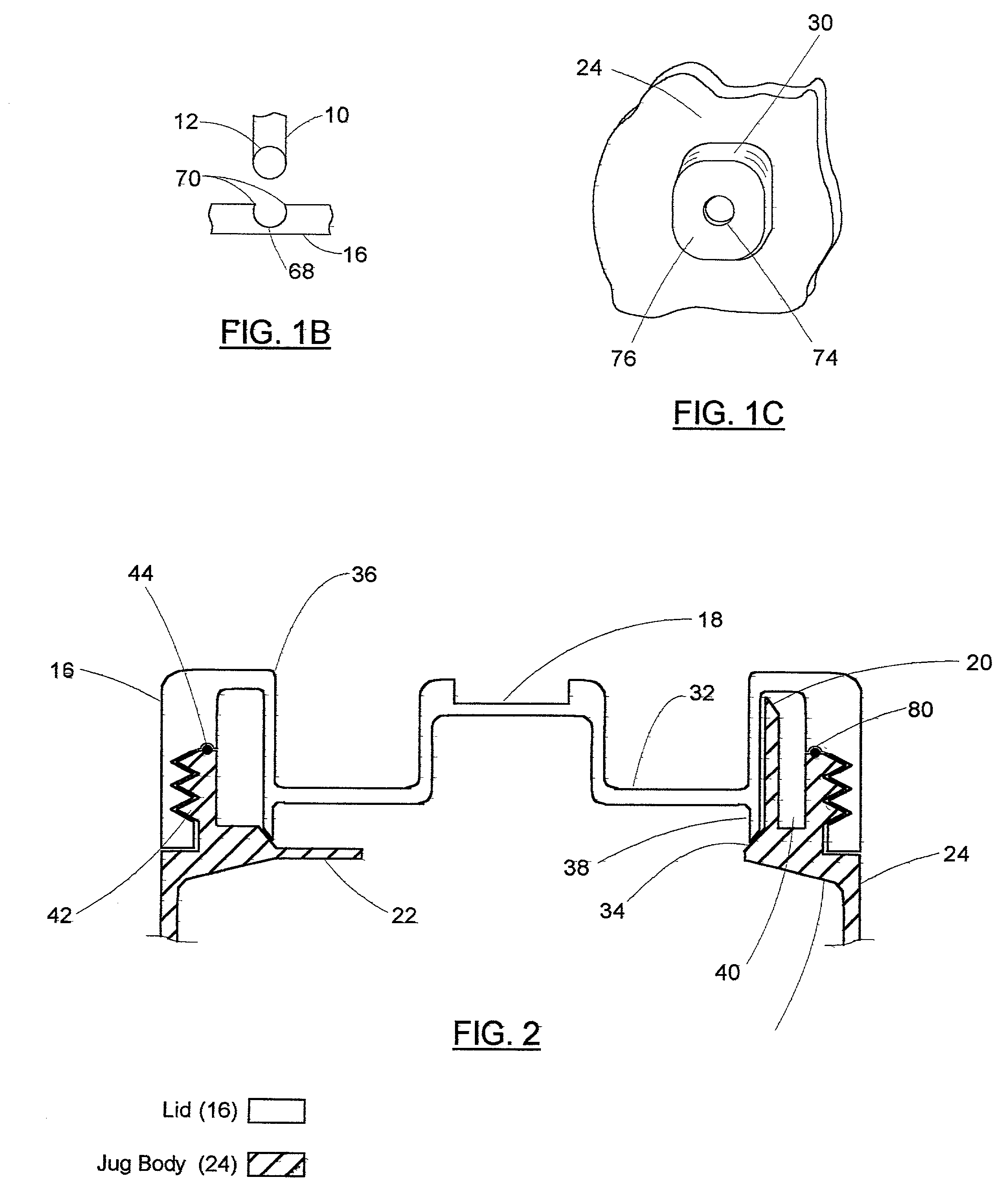This arrangement has many operational drawbacks that the industry has put up with for many decades These include the lack of a
locking mechanism that would prevent the friction lid, popping off if the can is dropped from a height as little as one meter, with consequent spilling of the contents widely on the ground.
The lid, moreover, must be pried off with a tool to
gain access to the paint, which proves a problem if no tool is available.
The prying action, moreover, often damages the lid sealing surface.
The can lip, furthermore, makes a very poor spout When the paint contents are transferred to another container, they must be poured across the grooved upper edge of the can, which inherently retains some of the paint, and the paint running down the outside of the can often obscure the
label, potentially reaching the users hands and the bottom surface The can, indeed, must be wiped nearly every time it is poured With the inside of the upper rim
trapping paint as it is poured, the user is never able to extract all available paint even if a
brush is used.
The circular shape of the can opening, in addition, is ineffective for wiping a flat
brush clean of excess paint.
Every time paint is poured from a can, the groove that accepts the lid fills with paint and it is very difficult to clean completely.
After repeated opening, pouring, and closing, in addition, the
mating surface becomes fouled and the friction seal fails.
Perhaps the biggest drawback of the current paint can, however, resides in the splattering of paint from the groove as the lid is pounded back on The pounding of the lid often damages both sealing surfaces, which again can cause the seal to fail Furthermore, paint in and around the groove can dry out and flake, leading to paint
contamination each time the can is jostled While
metal cans are coated to prevent
rust, this
coating often fails, which leads to
rust and paint
contamination Paint cans, in addition, do not stack well, and little disturbance is needed to cause them to slide off of one another.
As an example, U.S. Pat. No. 5,669,526 discloses a plastic paint can that has a small-
diameter, collapsible spout, non-contaminating lid seal, and straight edge formed in the can opening to facilitate
brush wiping This configuration, however, only addresses problems of paint
contamination, messy pouring, and non-uniform brush wiping inherent in the conventional metal paint can The narrow spout opening causes a slow pour rate and an undesirable chugging action as contents are poured.
U.S. Pat. No. 5,269,438 discloses a container with features designed to improve dispensing, such as a pivotally mounted carrying
handle that is offset from the opening to provide access It also has a wide pouring channel to improve flow, addressing to some degree a number of deficiencies The pop top of the lid, however, is not very secure and the spout does not prevent paint running down the side of the container.
A depression is formed in the lid to accept a mixing stick or the like to aid in tightening and undoing the lid This configuration, however, only addresses the problems of paint contamination and the difficult opening and closing of the lid inherent in the conventional metal paint can.
In U.S. Pat. No. 4,917,268, there is disclosed a liquid-dispersing
package with a spout that has a drain
back channel to return liquid drips to the container This configuration, however, only addresses the problem of difficult, messy pouring inherent in containers intended for dispensing low
viscosity liquids, but it does not work will with moderate
viscosity fluids, such as paint The tall and narrow design, moreover, eliminates the stackability of the container.
U.S. Pat. No. 4,619,373 discloses a plastic paint container with a lid that seals within the inner
diameter of the rim at the top of the container, to eliminate the poor sealing characteristics of the friction lid of the metal paint can It is still subject, however, to contamination of the seal by the paint itself, and does not provide for clean use or dispensing.
Like the other prior art, however, it does not provide for clean dispensing or use, nor does it address the difficulty that would be encountered with hand rotation of a firmly engaged, large
diameter friction seal lid.
Numerous other prior art proposals provide for attaching auxiliary components to existing metal cans Attachments are inherently deficient because they all require the additional operations of the attachment, removal, and cleaning which are inconvenient to the user For example, U.S. Pat. No. 4,702,395 discloses a
handle and pouring-spout arrangement intended for attachment to a conventional metal paint can The spout has an optional paint-drainback section.
This configuration, moreover, only attempts to solve the problem of difficult, messy pouring from conventional metal paint cans.
While the above-mentioned advances in the art each solve to some degree some of the major problems inherent in the conventional metal paint can, none of them solves a majority of the problems Some, moreover, improve only a subset of the problems and make improvements al the expense of some current favorable can features.
 Login to View More
Login to View More  Login to View More
Login to View More 


